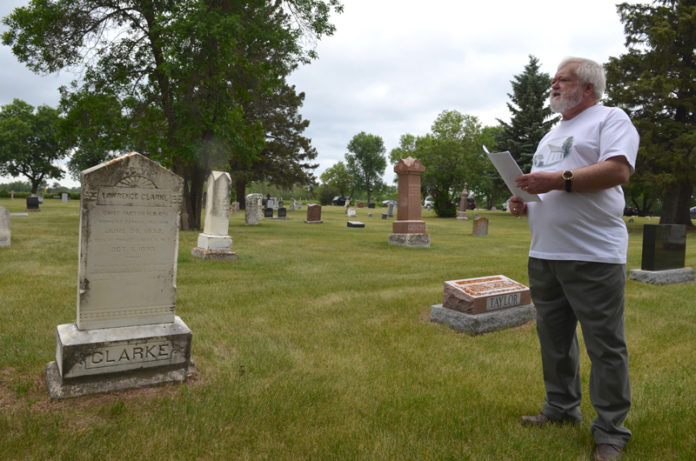
Fred Payton guides residents through the city’s early history through the stories of its former residents
No, Prince Albert didn’t choose a federal prison over a university.
The true story behind that permeating myth was one of many stories told by Fred Payton during the annual tour of the St. Mary Cemetery in mid-June.
The Anglican church began serving the community in the 1870s, serving as a parish church. In 1879, Emmanuel College was built by the Anglicans near where Saskatchewan Penitentiary now sits. In 1883, it received the Dominion Charter, incorporating it as the University of Saskatchewan.
With the formation of the Province of Saskatchewan, and with education falling under the provincial umbrella, a vote was held as to where the university should be set up. According to Payton, voters didn’t want to put it where the federal government had established the university (Prince Albert) and several provincial voters wanted to keep it away from the politicians in Regina. Ultimately, Saskatoon was chosen, and in 1909, the University of Saskatchewan was established, and both the university and Emmanuel College left for that city.
Wilfred Laurier’s ruling Liberals, with a strong presence in Prince Albert, later announced the city would be getting a federal penitentiary.
Payton suspects it as a political move, with the Liberals wanting to give Prince Albert a consolation prize.
“Don’t let anyone tell you Prince Albert chose,” to have a prison instead of a university, Payton said.
Though Emmanuel College moved away, St. Mary continued to be used as a parish church. As Prince Albert’s population grew on what was then Church Street (modern-day Central Avenue), St. Alban’s became more popular, and eventually, St. Mary seized to be used on a regular basis.
But while the church is only used a few times per year, it was home to many of Prince Albert’s early influential citizens, many of who are now buried in the adjacent cemetery.
Payton took a crowd of a few dozen people past some of the more prominent gravesites by St. Mary, including former mayors, a descendant of the kings of Ireland, and a member of Robert Peary’s exhibition to the North Pole.

He also stopped by a handful of men who played an important role in Canadian history, specifically, in the Battle of Duck Lake, the initial skirmish in the North West Rebellion.
Buried, almost side-by-side, are “Gentleman” Joe McKay, who fired the first shot, killing Isidore Dumont and Chief Assiwiyin; and James Isbister, the first man to settle in Prince Albert (predating James Nisbet by four years) and one of the men who went with Gabriel Dumont to bring Louis Riel back to Canada.
“There is a lot of history in this cemetery,” Payton said, adding that leading the tour was very “rewarding.
“I enjoy history. I’ve always enjoyed history. My father was at one time, president of the historical society. It’s a fit for me. My wife says it’s my happy place.”
Payton hopes more people take the time to explore the area’s history, as pivotal moments in Saskatchewan and Canadian history took place in the area.
“We tend to go to other communities and look at the history of those other communities, and think how fascinating it is,” Payton said.
“Then we come back here and we don’t look at our history. There is so much of value in the late 1800s, early 1900s about Prince Albert and area — the entire area, all the communities from Kinistino to North Battleford, down to Duck Lake, Rosthern even. Rosthern was a jumping off point for a lot of people who came to take the farmland in Saskatchewan. Many of those people had families who, later on, settled in Prince Albert.”
Payton said it was a joy to share just some of that history with members of the Prince Albert community.
“It’s a love for me,” he said. “So when I can share something that means so much to me with other people, it’s very rewarding.”

